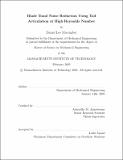Blade tonal noise reduction using tail articulation at high Reynolds number
Author(s)
Macumber, Daniel Lee, 1981-
DownloadFull printable version (4.636Mb)
Other Contributors
Massachusetts Institute of Technology. Dept. of Mechanical Engineering.
Advisor
Anuradha M. Annaswamy.
Terms of use
Metadata
Show full item recordAbstract
The biologically inspired method of tail articulation is investigated as a means of reducing tonal noise due to the stator wake blade interaction in underwater vehicles. This work is experimental in nature and conducted in the closed channel water tunnel at Naval Undersea Warfare Center in Newport, Rhode Island. Tail articulation is carried out with a life scale stator model with hinged flapping tail designed to (i) operate in freestream velocities corresponding to Reynolds number in the range 75,000 < Re < 300,000 and (ii) operate at frequencies up to 30 Hz in order to investigate the range of Strouhal number 0.0 < St < 0.35. Velocity measurements in the active stator wake are carried out by Laser Doppler Velocimetry, LDV, and Particle Image Velocimetry, PIV, in order to investigate the effects of tail articulation. Time averaged measurements of the stator wake by LDV show that Strouhal number of the tail articulation has a dominant effect on the time mean stator drag. Instantaneous phase averaged measurements of the stator wake by PIV show three regimes of the stator wake as Strouhal number is increased; quasi-steady wake spreading, vortex roll up, and strong vortex wake. A low order model describing the creation and convection of vorticity by tail articulation is developed which describes wake phenomena observed in experimental measurements. A two dimensional blade force simulation coupled with the reduced order tail articulation model is used to perimetrically search for a tail motion resulting in lower unsteady blade forces. (cont.) Finally, a three dimensional unsteady propeller simulation using both experimental wake velocity data by PIV and simulated wake velocity data generated by the reduced order tail articulation model is used to predict the effect of tail articulation on radiated noise. These simulations indicate that reduction of radiated noise by 5 dB or more is possible using tail articulation.
Description
Thesis (S.M.)--Massachusetts Institute of Technology, Dept. of Mechanical Engineering, 2005. This electronic version was submitted by the student author. The certified thesis is available in the Institute Archives and Special Collections. Includes bibliographical references (leaves 141-144).
Date issued
2005Department
Massachusetts Institute of Technology. Department of Mechanical EngineeringPublisher
Massachusetts Institute of Technology
Keywords
Mechanical Engineering.